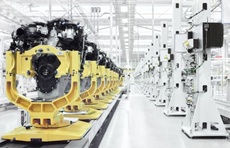JLR restarts engine manufacturing in UK after 18 years with new £500-mn plant
31 Oct 2014
Jaguar Land Rover cemented its position as the UK's leading automotive investor with the setting up of a new £500-million engine manufacturing centre, bringing engine manufacturing in-house for the first time in 18 years.
 Queen Elizabeth II inaugurated the new engine manufacturing centre, near the central English city of Wolverhampton in the West Midlands, on Thursday at a high-profile event attended by Ratan Tata and the Queen's husband, the Duke of Edinburgh, politicians and the plant's 300 current employees.
Queen Elizabeth II inaugurated the new engine manufacturing centre, near the central English city of Wolverhampton in the West Midlands, on Thursday at a high-profile event attended by Ratan Tata and the Queen's husband, the Duke of Edinburgh, politicians and the plant's 300 current employees.
The facility supports regional regeneration with 1,400 jobs created.
''The £500-mijllion facility, announced in September 2011, represents a significant step in Jaguar Land Rover's strategic investment programme and will see engines being produced in-house for the first time in a generation,'' the company stated in a release.
The new centre will manufacture the Ingenium engines, which will power a new generation of Jaguar Land Rover cars, starting with the 2.0-litre diesel, which rolls off the production line early next year, destined for the new Jaguar XE, the release stated.
''It's a very significant step in our global growth,'' said Mike Wright, executive director at JLR, in a round-table discussion ahead of the launch. Producing the light-weight efficient engines presents the company with the opportunity to attract a whole new series of customers. ''For the first time we have strategic control of the design and engineering and manufacture of engines. And for any automotive player, that is a very important strategic step.''
Commenting on the opening Ralf Speth, CEO of JLR, said, "The engine manufacturing centre represents all that is great about British engineering.
The day was one of the ''most important days in the company's history,'' said Speth at the ceremony in the diesel assembly hall of the plant at which the Queen, who arrived in a Range Rover, unveiled a plaque. ''It represents the revitalisation of Jaguar Land Rover that has taken place under the stewardship of the Tata Group,'' he added.
''The engine is at the heart of every car, and manufacturing engines in-house will help us meet our very ambitious cycle plan commitments,'' said Wolfgang Stadler, manufacturing director, during a presentation at the launch. ''We are now ready to deliver.''
JLR first announced plans to build the 100,000-sq metre plant (the size of 14 football pitches) in 2011, with construction beginning the following year. It includes an engine testing facility, manufacturing and separate assembly halls for diesel and petrol engines.
Jaguar Land Rover stopped making engines in April 1996, though it has always maintained control of the design process.
The first engine to be made at the new factory will be the low-emission 2-litre, four-cylinder 'Ingenium' diesel engine used in the Jaguar XE, the company's mid-sized executive ''attainable'' car, which it hopes will spur sales growth across the world.
JLR has not made its sales projections public. Jaguar sold 76,669 vehicles in 2013, while Land Rover sold 348,338. The XE is set to hit India in 2016 at the Delhi Auto show.
''Today is just a very important step, in terms of operating and manufacturing our engines, going into the biggest sector of the market,'' said Wright.
''Clearly this allows us to penetrate a price band in the market that we have hitherto been unable to penetrate. So, in that sense, it's very significant.''
In 2013, Jaguar Land Rover sold 425,006 vehicles, up 19 per cent. Of that, Jaguar sold 76,668 vehicles and Land Rover sold 348,338 vehicles.
Jaguar Land Rover is one of the UK's largest exporters and generates in the region of 85 per cent of its revenue from exports.
Jaguar Land Rover reported pre-tax profit of £924 million and revenue of £5,353 million in the first quarter of its financial year (April-June 2014). During the quarter, Jaguar Land Rover sold 115,596 vehicles. Of that, Jaguar sold 19,556 vehicles and Land Rover 96,040.
For the financial year ended March 2014, Jaguar Land Rover reported full-year results of £2,501 million pre-tax profit; £19.4 billion revenue; and retail sales of 434,311 vehicles.













.jpg)






.jpg)









